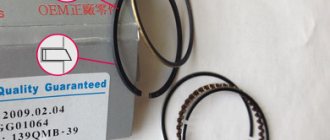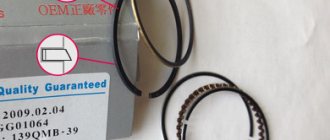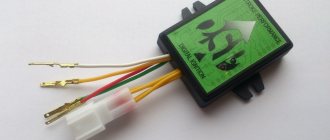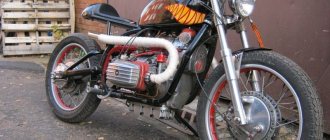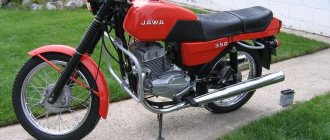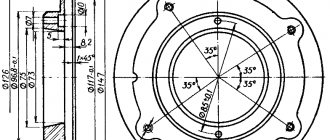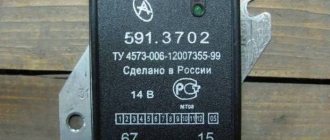Installing more powerful lighting on motorcycles and scooters is very popular. It's not only beautiful and interesting. Installing xenon lamps increases driver safety while driving, since the lighting becomes better and a motorcycle with such headlights will be visible from afar. Xenon lamps are significantly superior to halogen lamps in terms of lighting quality.
Features of using xenon
The principle of operation of xenon lamps is that under the influence of an electric current that passes through an inert gas, a glow occurs. It should be taken into account that the light beam that appears in the lamp is superior in its characteristics to other lighting sources.
Xenon is used for low and high beam. However, high beams can blind drivers of oncoming vehicles, which is at least unethical. Besides, it is quite dangerous !
In order to get an answer to the question of how to install xenon on a motorcycle, you should familiarize yourself with the types and parameters of lamps. Xenon lamps have three production series: H, D, HB. H series lamps have a light temperature from 3000 to 8000 K. Depending on the light temperature, lamps have various applications. They are installed in low beam, high beam, and fog lights. The D series is used primarily for low beam. HB series lamps are used quite rarely because they have a high light temperature.
The installation of xenon in headlights for halogen lamps is prohibited by law due to the fact that such lamps blind oncoming drivers. The use of xenon is only possible if these are either factory headlights designed specifically for this purpose, or modified ones that meet the requirements.
Installing xenon in headlights with special reflectors and lenses will not be visually very different from halogen headlights, but the quality of lighting will be higher. One of the conditions for using motoxenon is that the headlights must always be clean, since if there is dirt, the light refraction mechanism changes and the lamp will dazzle.
Separate classes of lamps
Separate classes of lamps include daytime running lights. As for Europe, they have been used here for a long time, but in the CIS countries they appeared on sale relatively recently. Today they are spelled out in all documents.
Why do you need this type of headlights? They are necessary in order to maximize the visibility of a car or motorcycle during daylight hours. Quite often, such material is confused with so-called dimensions, but this should not be done.
Many car manufacturing companies have long adopted such headlights and supply their models only with them. As for motorcycle manufacturers, they have only just begun to use them more widely. And this is quite strange, because we all know how bikers like to install a lot of headlights, right down to the handlebars of the motorcycle. All this is done to attract attention to your product. It is worth remembering that such headlights must be taken care of and turned off in time.
Advantages and disadvantages of installing xenon
Advantages of using xenon:
- The lamps have an emission spectrum that is as close as possible to daylight, which affects the comfort of sensations.
- The service life is significantly longer than other types of lighting. A xenon lamp is guaranteed to work for 2000 hours, while for a halogen lamp this figure is 1000 hours.
- Xenon lamps have a beneficial effect on the driver's vision; they do not lead to fatigue from prolonged driving at night.
Flaws:
- High cost of purchasing and installing the kit.
- The need for a powerful source of energy.<.li>
- Need an ignition unit.
- The heating temperature should not exceed 4800 K.
- Certain difficulties during installation.
</.li>
Other answers in this thread
Attached images
#8 Administrator
Ventel (10/13/2009, 10:49 am) wrote:
strong master. A xenon lamp is cooler and less energy-intensive (except for starting, you need to be insured) than a standard one, and even more so a halogen one.
The second question is that the light on the dio is often very controversially adjusted - it must be adjusted so as not to blind oncoming drivers.
#9 Ventel
Gruz (MOTOUA) (10/13/2009, 12:42) wrote:
strong master. A xenon lamp is cooler and less energy-intensive (except for starting, you need to be insured) than a standard one, and even more so a halogen one.
The second question is that the light on the dio is often very controversially adjusted - it must be adjusted so as not to blind oncoming drivers.
#10 LINCORN
The following question: I have a Venta 150 cc, on the front there are 2 double-spiral lamps of 25 watts each with an adapter for H4, I want to install bisenon. what is the current when starting these lamps? I will have a couple of them, it won’t happen that they simply won’t be able to start. and what power is the generator in my moped.
The question is probably not in this post))
Post edited by LINCORN: 22 April 2010 - 19:18
#11 Reiter
LINCORN (22.4.2010, 20:38) wrote:
The following question: I have a Venta 150 cc, on the front there are 2 double-spiral lamps of 25 watts each with an adapter for H4, I want to install bisenon. what is the current when starting these lamps? I will have a couple of them, it won’t happen that they simply won’t be able to start. and what power is the generator in my moped.
The question is probably not in this post))
Recently, Kent got 2 xenon lens units installed on his Kiwi 125. It turns out there is no distant one. Initially, there was 2 * 35 watts of light shining on the near side and switching to the far side (2nd spiral), so now one lens unit is only on fire, it turns out that the second one does not have enough power to start. The battery has 6 amperes, that is, you need at least 7, but it’s not a fact that it will start normally.
How to install xenon on a scooter and motorcycle
A xenon kit for a motorcycle consists of one lamp and an ignition unit. There are no differences between xenon for cars and motorcycles. In all respects, these are identical lighting devices. The process of installing xenon is quite complex, since it comes down to more than just replacing incandescent lamps. An ignition unit must be installed. The quality of the lighting and its service life depend on how well the installation is done.
The difficulty of installing xenon on a bike is that it requires a certain amount of space, which is often not available on a motorcycle. To solve this problem, ultra-thin ignition units that do not take up much space. When choosing the color temperature of motoxenon, you should not exceed 5000 K. This is the most optimal option for various weather conditions. Higher temperatures have proven to be ineffective in difficult weather conditions. And since riding a motorcycle becomes more difficult in rain or fog, inadequate lighting can cause an accident.
When installing motoxenon, a number of problems arise. Firstly, you need free space to place the ignition unit. Secondly, many lamps have a base designed for cars, and this requires additional modifications. A negative result of the “rework” may be depressurization of the system.
Thirdly, the motorcycle reacts more strongly to shaking and in a situation where the system is not completely sealed, the unit may not withstand the level of vibration. When installing xenon yourself, you should pay attention to such points as: choosing a unit in accordance with the size of the free space and ensuring complete tightness of the equipment . If necessary, a voltage stabilizer should be supplied.
A scooter differs from a motorcycle in its characteristics, so we will consider the xenon installation process separately. On many scooters, the headlight system, as well as the battery charging system, are designed in such a way that installing xenon is not possible. Provided that this system can be redone, the first step is to replace the generator relay. The wiring and generator should not be left unattended. The problem may also lie in selecting the size of the base. Most scooters have a non-standard headlight bulb, and xenon lamps are designed to fit the size of car headlights.
Therefore, the selection process can be quite lengthy. The problem lies not only in the selection of the lamp, but also in its further fastening. It should be taken into account that the lamp must not only be firmly fixed, but also be in the focus of the reflector. Otherwise, the flow of light will be disrupted, which is unsafe both for the motorcyclist and for oncoming vehicles.
Since the lighting system plays a decisive role in ensuring traffic safety, replacing incandescent lamps with xenon lamps should be approached very carefully. If you have the slightest doubt about your ability to perform this task well, it is better to leave the motorcycle in the hands of professionals.
General information
The driver can install xenon on a 50cc scooter independently or at a service center. The main task of xenon headlights is to illuminate the road at night. After all, the presence of light helps prevent accidents on the road.
Some motorcycle manufacturers install xenon lamps during production. For scooters, you can only use regular 35-watt lamps.
There are many difficulties during installation. High-quality, branded lamps are not cheap, and installing cheap ones is a violation of safety rules.
You can use xenon from China or Korea, but you should make sure that the quality is maintained at a high level.
Necessary concepts
Terms that the owner of a moped or scooter should know:
| Term | Meaning |
| Xenon ignition unit | This is ballast, equipment that is a component of an integral vehicle system. The unit is an electronic device and is used to start and maintain the operation of xenon arc lamps that supply head color |
| Xenon lamps | A device that serves as a light source. The lighting flow is formed by xenon, which burns in the atmosphere by an electric arc discharge. |
| Scooter or scooter | A special type of motorcycle. This type has the most comfortable fit. Includes recess for feet |
| Xenon | Chemical element of group 18 from the periodic table. Has atomic number – 54 |
It is better to entrust the installation of xenon, in the absence of skills, to professionals.
Basic parameters of the ignition unit
Using the ignition unit, you can use xenon on a 150 cc scooter. Most often, ignition units with the following technical parameters are used:
| Average voltage required for operation | 9 to 10 V |
| output power | About 36W |
| Minimum Voltage Required | 7.9 V |
| Peak current | Up to 7.5 Amps |
| Total current consumption | Up to 3.7 Amps |
| Temperature range | From 40 to 105 degrees C |
Protection is provided against voltages above 5V, as well as against sudden voltage surges or open circuits. This is one of the main advantages of xenon lamps.
The legislative framework
Regulations that must be followed when installing xenon on a scooter:
- Decree of the Government of the Russian Federation No. 1090 “On traffic rules”.
- UNECE Rules No. 99 and GOST standards R 41.99 - 99 “Uniform provisions concerning the official approval of gas-discharge light sources ... elements of motor vehicles.”
Monday, March 26, 2012
Guide to installing xenon on a 50cc scooter
The main problem when installing xenon on scooters with engines 139QMB (4-stroke), 1E40QMB (2-stroke) is that initially the headlight and dimensions are powered by alternating current, and the power of the original relay regulator is too small to compensate losses during operation of a xenon lamp. We will show you a practical solution to the problem.
So, the sequence is as follows:
We see the following picture:
3. Find the end of the coil winding soldered to the stator ground:
5. Solder a wire to this end of the winding:
6. We bring out this wire along with the rest of the generator wires:
8. Now we connect the wires from the generator to the relay:
In our example, a 125cc (152QMI) relay regulator was used. It has 6 wires, the connection is as follows: we connect 3 yellow wires with white, yellow and the wire that we brought out in any order. The green wire is from the relay with ground (frame, motor, battery negative), we don’t use the black one. We connect the red wire from the relay to the “plus” of the battery - it is convenient to connect to the power terminal of the starter relay.
9. Now we transfer all the lighting of the scooter from alternating current to direct current. On the connector intended for connection to the generator we find a wire going to the light. Usually this is either a white or yellow wire (yellow in our case). It's easy to check - connect the positive voltage to the battery and turn on the headlights or headlights with the ignition on. If they light up, it means they found them. We connect this wire to the “plus” of the ignition switch.
After this, the entire electrical circuit of the scooter runs on battery power, i.e. after turning the key to the ON position we can turn on the headlight and side lights.
If your scooter has a thermistor, it must be disconnected.
The simplest thing left is to replace the standard lamp with a xenon one.
10. Put the lamp in its original place (shown on the example of the Hongling Cruiser scooter, it has a standard lamp with an H4 socket):
11. It remains to convert the standard headlight connector to a xenon one:
Allowed or not
Before you begin choosing and installing xenon headlights, you need to understand the issue of the possibility of installing this type of lighting on a motorcycle.
In accordance with the clarifications of the Ministry of Internal Affairs, which were adopted on February 20, 2010, the following types of headlights are currently allowed on motorcycles and other types of vehicles:
Thus, the installation of xenon or bi-xenon lamps on a motorcycle is only permitted if a certain type of headlight is used.
All other situations, for example, installing a xenon lamp in a headlight intended for a halogen one, are considered a violation of the established rules and are punishable in accordance with Article 12.5 of the Code of Administrative Offenses by deprivation of the right to drive vehicles for a period of 6–12 months with the confiscation of devices that do not meet the requirements.
If for some reason (darkness, poor visibility, etc.) the headlight cannot be seized at the scene where the offense was discovered, then traffic police officers have the right to completely ban the use of a motorcycle in violation of its design features.
The issue of deprivation of rights will be considered in court.
If the design of the motorcycle does not provide for the possibility of replacing the lamp with a xenon one, then it is possible to completely replace the lighting devices on the vehicle.
To do this, it is necessary to carry out the procedure of re-equipping the motorcycle and adding xenon headlights to it.
The process of legalizing xenon is not particularly difficult. However, to legalize lamps of a different type, it is necessary to spend approximately 3–4 weeks of time and about 5,000–8,000 rubles (depending on the region of residence of the motorcycle owner).
The process of legalization itself is carried out according to the following scheme:
- the motorcycle is sent for a preliminary examination, at which the issue of the possibility of installing xenon on this particular vehicle is decided;
- with the result of the examination, you must contact the traffic police and obtain permission to install xenon;
- Next, equipment is selected in accordance with the recommendations of the traffic police and the priorities of the motorcycle owner;
- The equipment can be installed independently or at a service center. After installation of the equipment, a declaration of compliance with established standards is issued;
- A technical inspection is carried out at the traffic police, on the basis of which the changed data is entered into the PTS and the registration certificate.
Xenon headlights
Xenon for a motorcycle and a car has one feature that is common to both options - an arc that glows and is located in the bulb. It is filled with a special gas called xenon, hence the name of the headlight being described. It is precisely such a device that provides light that is closest in its characteristics to daylight.
By the way, such devices were invented before World War II. It is worth noting that they began to be widely used on cars and motorcycles in the early 90s of the last century.
Another feature of xenon is its service life - it is longer, unlike analogues of this lamp.
Regulator
Next, let's look at the regulator; many people confuse it with a switch; the switch relates to the ignition and has nothing to do with the rest of the electrical system. It is also called a voltage relay or a relay-regulator; this is also not correct; relay-regulators are used in conjunction with generators with an excitation winding; scooters do not have them. In scooters, a modern regulator does not contain any relays and consists of a low-power rectifier-stabilizer and a simple electronic circuit, usually based on a thyristor or triac, which regulates the voltage on the control winding. Fully adjustment looks like this: at startup, the voltage on the rectifiers reaches the required 13.8 volts, as soon as this happens, the stabilization circuit on the main winding is started; part of the voltage from the main winding is supplied to the regulating winding by pulses through a thyristor or triac; as a result, the action of induction and antiphases reduces the EMF in the coils and reduces voltage in the main winding. This scheme has many advantages: simplicity, compactness, low cost, low heat generation, and greater reliability. But there are also disadvantages: low efficiency, variable output voltage, voltage fluctuates greatly from 6 to 17 volts
All this is not important for the incandescent lamp in the headlight, for which the main winding is actually made, so the circuit can be considered ideal simply for a scooter, without tuning. To charge the battery, turn signals and instruments, a constant voltage is used produced by a low-power rectifier-stabilizer in the regulator, the same one that provides the reference voltage for controlling thyristors
Usually this current is no more than 2-3 amperes.
People who have no idea about the principle of operation of the regulator suggest connecting all additional equipment to the battery; the result is disastrous; first, everything works; the battery gives up its energy instead of being charged; then, as the battery discharges, the load on the regulator increases, and when the maximum is reached, the regulator overheats and burns out. . Modern regulators cannot be repaired, and buying a new one costs a lot of money. But what’s more, many manage to burn more than one regulator in this way until it reaches them. The only good thing about this situation is that many modern regulators have protection against overloads, both thermal and power, so that usually everything ends only with a discharged battery.
